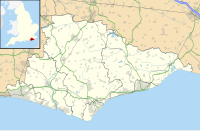
Back Pevensey Castle Catalan Pevensey Castle CEB Pevensey Castle Danish Kastelo Pevensey Esperanto Castillo de Pevensey Spanish قلعه پونزی Persian Château de Pevensey French Castello di Pevensey Italian Istana Kota Pevensey Malay Pevensey Castle NB
| Pevensey Castle | |
|---|---|
| Pevensey, East Sussex | |
 Aerial view of Pevensey Castle, showing the Norman keep and bailey at right within the Roman curtain wall; its main gate is at front | |
| Coordinates | 50°49′08″N 0°20′03″E / 50.8188°N 0.3342°E |
| Grid reference | grid reference TQ644048 |
| Type | Castle |
| Height | ~9.5 metres (31 ft) (outer walls) |
| Site information | |
| Controlled by | English Heritage |
| Condition | Ruin |
| Site history | |
| Built | c. 290 AD |
| Built by | Carausius? |
| In use | c. 290–471/491, 1066 – mid-16th century, 1940–1945 |
| Materials | Wood, cement, flint, chalk, ironstone, greensand, sandstone |
| Battles/wars |
|
| Events | Built by Romans (c. 290), reoccupied by Normans (1066), slighted (c. 1216), abandoned (16th century), state ownership (1925), reoccupied by Allies (1940–45) |
| Garrison information | |
| Garrison | Classis Anderidaensis, Abulci (Roman era), Norman & English forces (medieval era), Home Guard, British Army, Canadian Army, U.S. Army Air Corps (1940–45) |
Pevensey Castle is a medieval castle and former Roman Saxon Shore fort at Pevensey in the English county of East Sussex. The site is a scheduled monument in the care of English Heritage and is open to visitors. Built around 290 AD and known to the Romans as Anderitum, the fort appears to have been the base for a fleet called the Classis Anderidaensis. The reasons for its construction are unclear; long thought to have been part of a Roman defensive system to guard the British and Gallic coasts against Saxon pirates, it has more recently been suggested that Anderitum and the other Saxon Shore forts were built by a usurper in an ultimately unsuccessful attempt to prevent Rome from reimposing its control over Britain.
Anderitum fell into ruin following the end of the Roman occupation but was reoccupied in 1066 by the Normans, for whom it became a key strategic bulwark. A stone keep and fortification was built within the Roman walls and faced several sieges. Although its garrison was twice starved into surrender, it was never successfully stormed. The castle was occupied more or less continuously until the 16th century, apart from a possible break in the early 13th century when it was slighted during the First Barons' War. It had been abandoned again by the late 16th century and remained a crumbling, partly overgrown ruin until it was acquired by the state in 1925.
Pevensey Castle was reoccupied between 1940 and 1945, during the Second World War, when it was garrisoned by units from the Home Guard, the British and Canadian armies and the United States Army Air Corps. Machine-gun posts were built into the Roman and medieval walls to control the flat land around Pevensey and guard against the threat of a German invasion. They were left in place after the war and can still be seen today. Pevensey is one of many Norman castles built around the south of England.
© MMXXIII Rich X Search. We shall prevail. All rights reserved. Rich X Search
